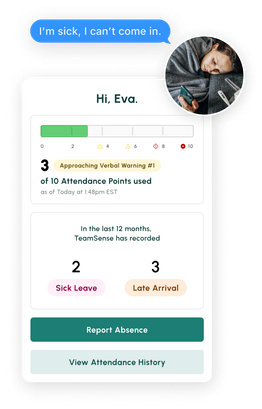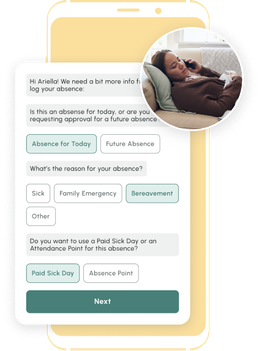Fix the root cause of No-Call No-Show with help from TeamSense
Table of Contents
- Legal Dimensions of No Call No Show in the Workplace
- No Call No Show vs. Job Abandonment
- The Impact of No Call No Show on Operations
- The Need for a No Call No Show Policy in Attendance Policy
- 1. Maintaining Operational Continuity
- 2. Ensuring Fair and Consistent Treatment of Employees
- 3. Protecting Against Legal Risks
- 4. Enhancing Workplace Culture
- 5. Reducing Employee Turnover
- Developing a No Call No Show Policy
- Steps to Create a Clear Policy
- Setting Consequences and Managing Exceptions
- Example No Call No Show Policy
- No Call No Show Policy Template
- Investigating and Responding to No Call No Show Cases
- The Importance of a Reliable Call-Off Solution to Minimize No Call No Shows
Unexpected employee absences, especially those without any notification, known as "No Call No Show" situations, can significantly disrupt operations, no matter the industry. An employee that no calls, no shows doesn't just affect productivity but also team morale and workflow efficiency.
In this comprehensive guide, we'll take a look at the nuances of managing no call no show scenarios effectively. Using manufacturing as our primary example of how no calls, no shows can turn operations upside down. I hope this will help ease the burden of managing no call, no shows, and shed some light on why they happen. But, not to worry, with the right insights and strategies, you will be able to minimize the impact of employee no call no show incidents, ensuring your team stays on track, and your operations run seamlessly.
Legal Dimensions of No Call No Show in the Workplace
In industries where precision and timely execution are pivotal, the concept of "No Call, No Show" takes on a critical significance. Frequent no call no show occurrences are not just a matter of absenteeism; they represent a break in the chain of reliability and trust that is essential in the manufacturing industry.
Defining No Call No Show from a Legal Perspective
Legally, "No Call No Show" refers to a situation where an employee fails to report to work and does not notify their employer in advance. This definition, while seemingly straightforward, can have varied interpretations based on the employment laws and regulations of different states and countries. We'll explore what legally constitutes a "No Call No Show" and how it differs from other forms of absenteeism.
The information below is for informational purposes only and should not be used in lieu of a legal consult. Reach out to your legal team before taking any action or creating a no call no show policy.
No Call No Show vs. Job Abandonment
In the context of workplace attendance, it's crucial to differentiate between "No Call No Show" incidents and job abandonment, as each has distinct implications for employers and employees.
No Call No Show: This term refers to situations where an employee fails to appear for a single scheduled shift without prior notification or explanation.
Job Abandonment: In contrast, job abandonment is characterized by an employee's complete and prolonged absence from work without any communication, indicating a lack of intention to return to their job. It's often interpreted as a voluntary resignation. Job abandonment can be inferred after a certain period of continuous no call no show, the duration of which varies based on the company's policies or legal guidelines. Unlike isolated no call no show incidents, job abandonment usually leads to the formal termination of employment.
Understanding the difference between these two scenarios is vital for employers. While no call no show incidents may warrant investigation and potentially lenient disciplinary actions depending on circumstances, job abandonment typically leads to a more definitive administrative response, such as termination of employment. Properly distinguishing between the two ensures fair and appropriate handling of attendance issues, in line with company policies and legal requirements.
Legal Boundaries and Employer Rights in No Call No Show Situations
On one hand, employers need to maintain operational efficiency and may consider taking disciplinary action against the absent employee. On the other hand, they must tread carefully, considering various employee protections under federal laws such as the Family Medical Leave Act (FMLA) and the Americans with Disabilities Act (ADA).
Employers have the right to enforce attendance policies and impose consequences for unnotified absences. However, they must also recognize situations where an absence is legally protected. For example, an employee may be entitled to take leave under FMLA for specific family and medical reasons, or accommodations may be required under ADA.
Employers should strive to strike a balance between ensuring operational continuity and adhering to legal requirements. It's important to have clear, well-communicated policies regarding attendance to deal with no call no-show scenarios and to approach each case with a thorough understanding of both the operational impact and the legal framework.

Is your call-in process terrible? Text reduces no-shows and absenteeism by up to 40%.
Don't believe us? Check out this case study to see how this 3PL benefited.
Evaluating No Call No Show Excuses: Valid vs Unacceptable
Understanding what constitutes a valid excuse for a "No Call No Show" and what does not is crucial. This discernment helps maintain fairness and operational efficiency, ensuring that genuine cases are treated with empathy while discouraging frivolous absences.
Examples of Valid No Call No Show Excuses
Valid excuses for a "No Call No Show" typically involve unforeseen circumstances where the employee is genuinely unable to notify the employer in advance. These might include:
- Medical Emergencies: Sudden illness or accidents that require immediate attention.
- Family Emergencies: Urgent situations involving family members, such as accidents or severe illness.
- Transportation Issues: Unforeseen problems like vehicle breakdowns or public transport disruptions.
- Natural Disasters: Events like severe weather conditions that prevent safe travel to work.
- Communication Failures: Situations where the employee attempts to contact the employer but is unable due to technical issues.
Understanding and acknowledging these scenarios helps in fostering a supportive and empathetic workplace culture.
Examples of Unacceptable No Call No Show Excuses
Unacceptable excuses for a "No Call No Show" are typically those that could have been anticipated or communicated in advance. Examples include:
- Non-urgent Personal Matters: Such as attending a concert or a non-critical appointment.
- Avoidable Transportation Issues: For example, not refueling the car or missing a bus due to poor time management.
- Minor Illnesses or Discomforts: Where the condition is not severe enough to impede communication.
- Recreational Activities: Planning a day out or a trip without prior notification or leave application.
- Repeated Patterns: Regularly citing the same excuse, indicating a pattern of irresponsible behavior.
Distinguishing between valid and unacceptable excuses is key to managing no call no show situations effectively. It ensures that while genuine cases are treated with understanding, a culture of accountability and responsibility is maintained among all employees.

The Impact of No Call No Show on Operations
The absence of a team member without prior notice can have a domino effect in sectors where hourly employees are crucial to success. It can lead to production delays, missed delivery deadlines, and a strain on your remaining workforce. This section will look at how these incidents can disrupt workflows, affect team morale, and potentially compromise workplace safety for other employees, underlining the importance of addressing this issue proactively.
The Need for a No Call No Show Policy in Attendance Policy
In the highly structured and time-sensitive realms of manufacturing, retail, entertainment, and hospitality, the implementation of a clear and comprehensive "No Call No Show" policy is not just beneficial, but essential. Such a policy serves multiple purposes, from maintaining operational efficiency to ensuring fair treatment of all employees.
1. Maintaining Operational Continuity
The unplanned absence of a single employee in a no call no show situation can disrupt the entire workflow in these industries. For instance, in manufacturing, an unstaffed position on an assembly line can halt production, while in logistics, a missing team member can delay shipments. A well-defined no call no show policy helps in quickly addressing these absences, minimizing the impact on operations.
2. Ensuring Fair and Consistent Treatment of Employees
A standardized no call no show policy ensures that all employees are aware of the expectations regarding attendance and the consequences of unnotified absences. This clarity fosters an environment of fairness and consistency, crucial for employee morale and trust.
3. Protecting Against Legal Risks
Having a documented no call no show policy can also protect your organization legally. It provides a framework for handling absenteeism while complying with employment laws, reducing the risk of legal challenges related to wrongful termination or discrimination claims.
4. Enhancing Workplace Culture
A clear policy underscores the importance of responsibility and reliability, values that are fundamental in every workplace that wants to run smoothly. It helps cultivate a culture where employees understand the significance of their roles and are motivated to adhere to the attendance rules and norms.
5. Reducing Employee Turnover
By addressing no call no show situations proactively and fairly, employers can reduce frustration among employees who often bear the additional burden in such scenarios. This can lead to improved job satisfaction and lower turnover rates.
Developing a No Call No Show Policy
For businesses with a high level of hourly employees, which are crucial to general operations, a comprehensive "No Call No Show" policy is crucial for maintaining an efficient and harmonious workplace. This policy should be clear, concise, and tailored to the specific needs and dynamics of the industry.
Steps to Create a Clear Policy
Creating an effective no call no show policy involves several key steps:
- Define 'No Call No Show': Clearly articulate what constitutes a no call no show situation in your organization. This definition should be straightforward and understandable for all employees.
- Outline the Reporting Process: Specify the acceptable methods and timeframe for reporting absences. This includes whom to contact and how (e.g., text, phone call).
- Incorporate Legal Considerations: Ensure that the policy is in compliance with local and federal employment laws, including provisions for protected leaves like intermittent FMLA and ADA.
- Communicate the Policy: The policy should be communicated effectively to all employees. This could be through staff meetings, handbooks, and training sessions.
- Integrate with Other Policies: The no call no show policy should be consistent with other related policies such as leave, tardiness, and general attendance.
Setting Consequences and Managing Exceptions
Establishing the consequences for no call no show incidents is a vital part of the policy. This section should address:
- Progressive Discipline: Implement a system of progressive discipline, such as starting with a verbal warning, then a written warning, and possibly leading to termination for repeated offenses.
- Exception Handling: Clearly state the exceptions to the policy. Recognize situations like emergencies where the employee might be genuinely unable to notify in advance.
- Documentation Requirements: Outline the documentation required for excused absences, such as medical certificates in case of illness.
- Appeal Process: Provide an avenue for employees to appeal or explain their no call no show incidents, ensuring fairness and transparency.
- Regular Review and Update: Regularly review and update the policy to reflect any changes in the law or company operations.
By carefully developing a no call no show policy that is clear, fair, and legally compliant, employers in can effectively manage workforce attendance while maintaining a positive and productive work environment.

No Call No Show Policy Template
1. Policy Overview: This policy outlines our expectations regarding employee attendance, specifically addressing situations of no call no show. A no call no show incident occurs when an employee fails to report to their scheduled shift and does not communicate their absence to their supervisor or designated contact person in advance.
2. Reporting Absences: Employees are required to notify their supervisor or designated contact at least [X hours] prior to their shift if they are unable to attend. Notification should be made via [acceptable methods, e.g., phone call, email, text message].
3. Definition and Examples of No Call No Show: A no call no show incident is defined as an absence from a scheduled shift without prior notification. Examples include but are not limited to failing to report to work and not calling to inform the supervisor, not responding to inquiries about an unexplained absence, etc.
4. Consequences of No Call No Show: The following disciplinary actions will be taken for no call no show incidents:
- First Offense: Verbal warning and documentation in employee file.
- Second Offense: Written warning and possible suspension.
- Third Offense: Termination of employment.
5. Exceptions to the Policy: Exceptions to this policy will be considered on a case-by-case basis. Valid exceptions may include medical emergencies, severe weather conditions, and other extenuating circumstances. Documentation (e.g., medical certificate) may be required for the absence to be excused.
6. Appeals and Disputes: Employees who believe their no call no show incident was unjustly recorded or wish to dispute the disciplinary action may appeal to [designated person or department] within [X days] of the incident.
7. Policy Review and Amendments: This policy is subject to review and amendments to stay compliant with state and federal employment laws. Employees will be notified of any changes.
This template is intended to serve as a starting point. It's crucial to tailor the policy to the specific needs of your organization and ensure that it complies with all relevant legal requirements. Regular training and communication are key to ensuring that all employees understand and adhere to the policy.

No one wants to talk to their boss or a 1-800 stranger to call off. Text changes everything - Reducing No Call No Shows.
Investigating and Responding to No Call No Show Cases
Handling no call no show cases effectively requires a methodical approach. This involves thorough investigation procedures followed by appropriate disciplinary actions, ensuring fairness and maintaining workplace standards.
Investigation Procedures
When an employee fails to report for their shift without prior notification, the following investigation procedures should be initiated:
- Immediate Response: The supervisor or HR representative should promptly note the absence and check whether the employee has attempted any form of communication.
- Attempt to Contact the Employee: Make efforts to contact the employee using the provided contact information. This can include phone calls, emails, or text messages.
- Review the Employee's History: Examine the employee’s attendance record for any patterns or previous instances of no call no show.
- Consider Possible Emergencies: Evaluate if the absence could be due to an emergency, particularly if it’s out of character for the employee.
- Gather Information: Collect any relevant information or context that might explain the absence, including recent workplace incidents or personal issues the employee might be facing.
- Documentation: Keep a record of all steps taken during the investigation, including times and modes of attempted contact and any responses received.
Appropriate Disciplinary Actions
Once the investigation is complete, the following disciplinary actions can be considered, depending on the circumstances:
- First Incident: If it’s a first-time occurrence and no valid reason is provided, issue a verbal warning and document the incident.
- Repeated Incidents: For repeated no call no show behavior, escalate to written warnings or suspension, depending on the severity and frequency.
- Extenuating Circumstances: If the investigation reveals a valid reason for the absence, consider excusing the incident, particularly for emergencies or unavoidable circumstances.
- Termination: In cases of chronic absenteeism without valid reasons or response to disciplinary actions, termination of employment may be necessary.
- Communication: Clearly communicate the outcome of the investigation and any disciplinary action taken to the employee. Ensure that the process and decision are documented for HR records.
By adhering to these procedures, employers can effectively manage no call no show cases, maintaining a balance between operational needs and fair treatment of employees.
Preventing No Call No Show Incidents
Implementing specific strategies and fostering a workplace culture that emphasizes clear communication and mutual respect can significantly decrease the frequency of these occurrences.
Proactive Methods to Reduce Incidents
To proactively reduce no call no show incidents, consider the following methods:
- Clear and Regular Communication: Ensure that all employees are aware of the attendance policy, including the importance of notifying supervisors about absences. Regular reminders can reinforce this message.
- Easy Reporting Systems: Implement user-friendly systems for reporting absences, such as a dedicated phone number connected to text or a hotline. The easier it is for employees to report, the less likely they are to skip this step.
- Flexible Scheduling Options: Where possible, offer flexible scheduling or shift swapping options. This can help employees manage personal obligations without resorting to unnotified absences.
- Attendance Incentives: Consider introducing incentives for good attendance, such as recognition programs, bonuses, or additional time off.
- Employee Support Programs: Provide support for common issues that lead to absences, such as transportation assistance, childcare solutions, or employee assistance programs for personal issues.
The Role of a Positive Work Environment and Clear Policies
A positive work environment and clear policies play a crucial role in preventing no call no show incidents:
- Cultivating a Culture of Responsibility: Foster a workplace culture where responsibility and reliability are valued and recognized. This can encourage employees to adhere to attendance policies.
- Building Trust and Open Communication: Encourage open lines of communication between employees and management. When employees feel they can talk openly about their challenges, they are more likely to communicate about potential absences.
- Consistency in Policy Enforcement: Apply the attendance policy consistently and fairly to all employees. This consistency helps build trust and understanding of the importance of adherence to policies.
- Employee Engagement and Feedback: Actively engage with employees and seek their feedback on attendance policies. Understanding their perspectives can help in refining policies to better suit the workforce's needs.
- Training and Awareness: Regularly train supervisors and managers on how to handle no call no show incidents compassionately and effectively, ensuring they are equipped to deal with these situations.

The Importance of a Reliable Call-Off Solution to Minimize No Call No Shows
A reliable call off solution plays a pivotal role in achieving a reduction of employee no call no shows by providing a straightforward and accessible way for employees to report absences. TeamSense stands out as an effective solution, specifically designed to cater to the needs of the hourly workforce.
TeamSense: Streamlining Absence Reporting via Text
TeamSense is the call off solution for hourly employees! Simplifying the call in process is the first step to reducing no call no shows and when you give employees the power to text in - they do it! TeamSense significantly reduces the barriers to communication that often lead to no call no show incidents - like not wanting to sit on hold, or feeling so ill that talking to a person feels daunting.
Implementing TeamSense can have a direct impact on reducing absenteeism and no call no show rates, as much as 40% in manufacturing environments. By making the process of reporting absences hassle-free and immediate, TeamSense encourages employees to communicate their inability to attend work, thereby reducing unexplained absences. The data collected through TeamSense can also provide valuable insights for employers to understand and address the root causes of absenteeism, further enhancing the effectiveness of attendance management strategies.
Incorporating a reliable call off solution like TeamSense is a strategic move for forward-thinking companies aiming to minimize no call no show incidents.
FAQs
-
Proactively managing potential "No Call No Show" issues involves a combination of clear communication, supportive workplace culture, and strategic use of technology. Managers can implement the following strategies to effectively address these challenges before they become more significant problems:
- Open Communication Channels: Encourage an open dialogue about attendance expectations and the impacts of no-shows. Make it clear to employees that they can discuss their challenges and seek help when needed. Regular team meetings and one-on-one sessions can help managers stay informed about any issues that might affect attendance.
- Flexible Work Arrangements: Where possible, offer flexible scheduling options. This flexibility can include shift swaps, flexible start times, or remote work opportunities. Such options can help employees manage personal obligations more effectively, thereby reducing the likelihood of unexpected absences.
- Early Identification of Patterns: Use attendance tracking software to identify patterns of absenteeism early. If a pattern is emerging, such as frequent absences on specific days or following certain shifts, managers should have a confidential discussion with the employee to understand any underlying issues and offer support or solutions.
- Supportive Policies and Practices: Develop a supportive policy that includes clear procedures for reporting absences. Make sure employees are aware of how to communicate their inability to attend work. Policies should also outline the support available to employees, such as counseling services or assistance programs.
- Training for Supervisors: Train supervisors and managers on how to handle absences compassionately and effectively. They should know how to apply the attendance policy fairly while being sensitive to individual circumstances.
- Employee Engagement and Feedback: Actively engage with employees and seek their feedback on the attendance policy and workplace environment. High engagement levels can improve morale and reduce absenteeism. Regular feedback sessions can also help identify and address specific issues that lead to no-shows.
- Incentives for Good Attendance: Consider implementing rewards for consistent attendance. Recognition programs, performance bonuses, or extra time off can motivate employees to adhere to scheduled shifts.
By employing these strategies, managers can create a workplace environment that minimizes the occurrence of "No Call No Show" incidents and supports employees in managing their work-life balance more effectively. This proactive approach not only helps in reducing absenteeism but also contributes to a more engaged and productive workforce.
-
Tailoring a "No Call No Show" policy to align with the diverse needs of a workforce across different industries requires a nuanced approach that considers unique challenges, operational demands, and communication capabilities. In industries such as healthcare or manufacturing, where absenteeism can jeopardize safety and disrupt operations, a stringent policy may be necessary. In contrast, corporate office settings, where impacts might be limited to project timelines, could adopt a more flexible approach.
Understanding the operational requirements of different roles within the organization is crucial. For example, customer-facing or teamwork-centric roles in retail or hospitality may require stricter policies due to the direct impact on service and colleague workload, whereas roles that are easier to adjust or cover might allow for more leniency. The communication tools available to employees also play a significant role. In sectors like technology or finance where digital communication tools are ubiquitous, employees can easily report absences. However, in industries like construction or warehousing, simpler methods such as SMS notifications or a dedicated hotline may be more effective.
It's also important to consider the cultural dimensions of the workforce. A policy that respects cultural differences, including observance of religious holidays or community obligations, can reduce no-show incidents and promote inclusivity. Legal compliance with employment laws at federal, state, and local levels is essential to ensure that the policy respects worker rights and leave entitlements, which can vary widely.
Involving employees in the policy development through surveys or focus groups can provide insights into potential issues and increase acceptance. Implementing a flexible and supportive framework, such as providing options for makeup shifts or offering emergency support services, can help manage personal challenges that might lead to absences.
Finally, regular reviews of the policy ensure it remains effective and relevant, adapting to changes in workforce composition, industry standards, or legal requirements. By thoughtfully adapting the "No Call No Show" policy to the diverse needs of the workforce and specific industry demands, companies can effectively manage absenteeism, support their employees, and maintain operational efficiency.
-
Balancing disciplinary actions with employee support in "No Call No Show" situations requires a nuanced approach that prioritizes understanding and fairness while maintaining clear standards and expectations. The key is to create a policy that is both strict enough to deter unnecessary absences and flexible enough to accommodate genuine emergencies or unforeseen circumstances.
Employers should start by establishing a clear and comprehensive "No Call No Show" policy that outlines the expectations and consequences clearly. This policy should be communicated thoroughly during onboarding and reinforced regularly through training sessions and reminders. Having a clear policy helps set a baseline for both employers and employees, ensuring everyone understands what is expected and the repercussions of not meeting these expectations.
When an absence occurs, the initial step should be to investigate the situation thoroughly before taking any disciplinary action. This involves reaching out to the employee to understand their reasons for the absence. Sometimes, what seems like a clear-cut case of negligence might be a misunderstanding or a serious emergency that prevented the employee from calling in.
Supportive measures can include establishing multiple channels for employees to report absences, such as text messages, emails, or a dedicated hotline, which can accommodate different situations and needs. Providing resources like employee assistance programs or counseling services can also support employees who might be dealing with personal issues that affect their attendance.
When disciplinary actions are necessary, they should be applied consistently and fairly, following the established policy. Implement a progressive discipline system that starts with a verbal warning and escalates to more severe consequences for repeated offenses. This system not only gives employees a chance to correct their behavior but also demonstrates that the employer is reasonable and fair in their approach.
Additionally, employers should always consider any legal protections that might apply, such as those under the Family and Medical Leave Act (FMLA) or the Americans with Disabilities Act (ADA), before taking any disciplinary action. Understanding and respecting these legal requirements can prevent potential legal issues and promote a supportive workplace culture.
About the Author

Jackie Jones, Employee Engagement & Attendance Specialist
Jackie Jones has over three years of experience helping HR teams improve employee morale, reduce absenteeism, and create happier, more engaged workplaces. With a strong background in employee relations and attendance management, she brings practical strategies and insights that support frontline teams and the HR professionals who lead them.





